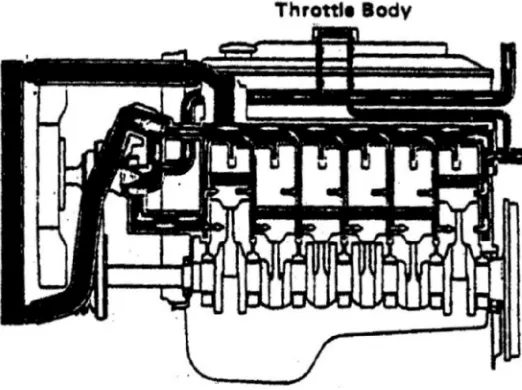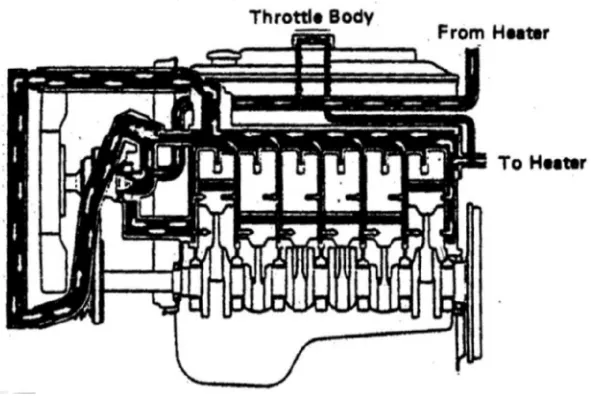CHAPTER I INTRODUCTION
1.1 Background
Although gasoline engines have improved a lot, they are still not very
efficient at turning chemical energy into mechanical power. Most of the
energy in the gasoline (around 75%) is converted into heat, and only 25% of
total energy produced in gasoline engine which converted into effective work.
Therefore, it is the job of the cooling system to take care of that heat. In fact,
the cooling system on a car driving down the freeway dissipates enough heat
[image:1.612.172.486.423.591.2]to heat two average-sized houses.
Figure 1.1 Heat Balance In Gasoline Engine
The primary work of the cooling system is to keep the engine from
overheating by transferring this heat to the air, but the cooling system also has
temperature. When the engine is cold, components wear out faster, and the
engine is less efficient and emits more pollution. So another important work
of the cooling system is to allow the engine to heat up as quickly as possible,
and then to keep the engine at a constant temperature.
Therefore, knowledge about the design and analysis of radiator car is
very important to be studied by engineering students at university.
1.2 Car Cooling System
A car engine is made up of numerous internal moving parts that
cannot be seen. When the engine is running, these parts move very quickly
and create friction which then, creates heat. It is normal for a car engine to
operate at a high temperature but extreme heat cannot be maintained and it
must be moved on or the internal parts will be fatigue and the engine is worn.
This is where the engine cooling system and the radiator come in. The
purpose of the cooling system is to absorb excess heat generated by the
engine.
1.2.1 Function
Specific functions of car cooling system are:
a. To reduce engine heat. Heat which produced by combustion
process could reach 2500°C. This heat is enough to melt metal or
other engine components, so if car is not equiped with cooling
b. Maintaining the most efficient working temperature of engine
which is 82°C to 99°C. At working temperature components will
expand so that clearance of components of the engine becomes
precise. Besides, the works of the engine will become maximum
and the exhaust gas emission will reduce.
c. Accelerate reaching working temperature to avoid excess worn of
engine componets.
d. To warm up car cabin, especially in country which winter season
occur.
1.2.2 Work
When the engine in low temperature, water circulate in around
the engine only, since the thermostat still closed. Water gets pressure
from water pump, but it can not force thermostat to open since
[image:3.612.214.475.481.676.2]thermostat works based on temperature changing.
To avoid excessive pressure of pumping process then cooling
system is equiped with by pass valve on radiator cap.
When the engine in high temperature, thermostat is open so that
hot water in water jacket (which already absorb heat from engine)
flowing from engine to radiator that will be cooled by radiator, cooling
fan, and air flow by forward movement of car. From radiator water
[image:4.612.196.492.293.495.2](which already cooled) flow again to engine.
Figure 1.3 Cooling System When Thermostat Open
1.3 Objectives
Objective of this final project are:
1. To investigate heat transfer rate through radiator.
2. To create simple segment analysis which then compared to
1.4 Problem Limitations
Scope of work for this project is used as limitation which available to be
discussed and analyzed. Limitations are as follows:
1. Radiator of Toyota Rush 1.5 M/T.
2. Analyzing of heat transfer in radiator when thermostat open.
3. Analyzing of heat transfer in radiator when fan starts.
4. Engine is on idle RPM (around 850 RPM).
1.5 Methodology
This car radiator heat transfer analysis done by several methods, namely:
1. Observation methods: by observing, analyzing and searching the data
directly in the subject.
2. Literature methods: to obtain the basic of theory using equations or
formulas from an existing reference.
3. Internet searching: to search the data components of car radiator, this can
be accessed by internet.
4. Interview method: to obtain information and data by asking directly to the
related resource.
1.6 Systematic Writing
This final project consists of several chapters. In broad outline of each
chapter contains the following:
Chapter I INTRODUCTION
This chapter contains background, car cooling system, objective,
scope area, methodology and systematic writing.
Chapter II REVIEW OF LITERATURE
This chapter contains review of literature and theory of
conduction, convection, radiation, fins, mass flow rate, friction,
turbulent flow, laminar flow, and pump.
Chapter III COOLING SYSTEM OF TOYOTA RUSH 1.5 M/T
This chapter contains flow chart of research, four stroke internal
combustion engine, combustion process, cooling system of
Toyota Rush 1.5 M/T, and its main components.
Chapter IV CALCULATION ANALYSIS
This chapter contains calculation analysis of radiator.
Chapter V CONCLUSION


